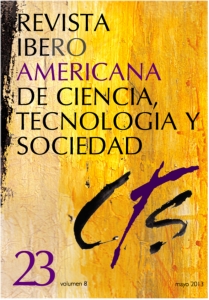Time and new technologies from the perspective of the systems theory
DOI:
https://doi.org/10.52712/issn.1850-0013-643Keywords:
temporality, Luhmann, media, communicationAbstract
According to many theorists, but also as said by laymen, the emergency of the new information and communication technologies (ICTs) has generated deep transformations on the way the relationship between time and space is daily conceived and experienced. This paper tries to problematize this relationship between ICTs and temporality, departing from Niklas Luhmann’s systems theory. In order to illuminate this relationship, it will be necessary to start with a rereading of the theorists who have already dealt with this problem. At the same time, it will be also indispensable to reconstruct Luhmann’s perspective on time and ICTs, even if this last matter was only briefly examined by the author. On these basis and supported on the results of empirical research, we will work on the temporal transformations produced on communication as a consequence of the emergency of ICTs as a media. As a corollary to this inquiry, we will observe the repercussions that this issue has provoked on consciousness.
Downloads
References
BAECKER, D. (2007): “Communication With Computers, or How Next Society Calls for an Understanding of Temporal Form”, Soziale Systeme, vol. 13, nº 1+2, pp. 409-420.
BITTMAN, M.; BROWN, J. y WAJCMAN, J. (2009): “The Cell Phone, Constant Connection and Time Scarcity in Australia”, Social Indicator Research, vol. 93, pp. 229-233.
CASTELLS, M. (2010): The Rise of the Network Society, The Atrium, John Wiley and Sons.
CASTELLS, M.; FERNANDEZ-ARDEVOL, M-; LINCHUAN QIU, J. y SEY, A. (2004): The Mobile Communication Society: Across cultural analysis of available evidence on the social uses of wireless communication technology, Los Angeles, University of Southern California.
ELCHARDUS, M. (1988): “The Rediscovery of Chronos: The New Role of Time in Sociological Theory”, International Sociology, vol. 3, nº 1, pp. 35-59.
GIDDENS, A. (1984): The Constitution of Society. Outline of the Theory of Structuration, Oxford, Polity Press.
GLEICK, J. (1999): Faster. The Acceleration of Just About Everything, Nueva York, Random House.
GLEICK, J. (1990): The Consequences of Modernity, Oxford, Polity Press.
GUMBRECHT, H. U. (2001): “How is Our Future Contingent? Reading Luhmann Against Luhmann”, Theory Culture Society, vol. 18, nº 1, pp. 49-58.
HASSAN, R. (2003): The Chronoscopic Society. Globalization, Time and Knowledge in the Network Economy, Nueva York, Peter Lang Publishing.
JAUREGUIBERRY, F. (2007): “Les téléphones portables, outils du dédoublement et de la densification du temps : un diagnostic confirmé”, Tic & Société, vol. 1, nº 1, pp. 79-103.
LASH, S. (2002): Critique of Information, Londres, Sage Publications.
LASH, S. y URRY, J. (1994): Economies of Signs and Space, Londres, Sage Publications.
LATOUR, B. (1997): “Trains of thought—Piaget, formalism and the fifth dimension”, Common Knowledge, vol. 6, nº 3, pp. 170–191.
LEONG, S.; MITEW, T.; CELLETTI, M. y PEARSON, E. (2009): “The question concerning (internet) time”, New Media Society, vol. 11, nº 8, pp.1267-1285.
LUHMANN, N. (1976): “The Future cannot Begin: Temporal Structures in Modern Society”, Social Research, vol. 43, nº 1, pp. 130-152.
LUHMANN, N. (1984): Soziale Systeme. Grundriß einer allgemeinen Theorie, Frankfurt a.M., Suhrkamp Verlag.
LUHMANN, N. (1996): La ciencia de la sociedad, México DF, Anthropos.
LUHMANN, N. (1997a): Die Gesellschaft der Gesellschaft, 2 Bd. Frankfurt a.M., Suhrkamp Verlag.
LUHMANN, N. (1997b): “La cultura como concepto histórico”, Historia y Grafía, vol. 8, pp. 11-33.
LUHMANN, N. (1998): Sistemas Sociales. Lineamientos para una teoría general, Barcelona, Anthropos.
LUHMANN, N. (1999): “Tiempo del mundo e historia sistémica”, Inguruak, vol. 23, pp. 13-54.
LUHMANN, N. (2000): La realidad de los medios de masas, Barcelona/México DF, Anthropos/Universidad Iberoamericana.
LUHMANN, N. (2007): La sociedad de la sociedad, México DF, Herder.
LUHMANN, N. (2009): „Gleichzeitigkeit und Synchronisation“, Soziologische Aufklärung 5. Konstruktivistische Perspektiven, Wiesbaden, VS Verlag, pp. 92-125.
MACKENZIE, A. (2005): “Protocols and the irreducible traces of embodiment: the Viterbi algorithm and the mosaic of machine time”. Disponible en: http://www.lancs.ac.uk/staff/mackenza/papers/mackenzie-algorithmic-time.pdf. Consultado el 17 de agosto 2011.
MARTON, A. (2009): “Self-Referential Technology and the Growth of Information: From Techniques to Technology to the Technology of Technology”, Soziale Systeme, vol. 15, nº 1, pp. 138-159.
NASSEHI, A. (1994): “No Time for Utopia: The Absence of Utopian Contents in Modern Concepts of Time”, Time Society, vol. 3, nº 1, pp. 47-78.
NIE, N.; HILLYGUS, S. y ERBRING, L. (2002): “Internet Use, Interpersonal Relations, and Sociability a Time Diary Study”, en B. Wellman, y C. Haythornthwaite (eds.): The Internet in Everyday Life, Oxford, Blackwell Publishers, pp. 215-243.
SCHWANEN, T. y KWAN, M. (2008): “The Internet, mobile phone and space-time constraints”, Geoforum, vol. 39, pp. 1362-1377.
SPENCER BROWN, G. (1972): Laws of form, Nueva York, The Julian Press Inc.
Downloads
Published
How to Cite
Issue
Section
License
Copyright (c) 2024 CC Attribution 4.0

This work is licensed under a Creative Commons Attribution 4.0 International License.
All CTS's issues and academic articles are under a CC-BY license.
Since 2007, CTS has provided open and free access to all its contents, including the complete archive of its quarterly edition and the different products presented in its electronic platform. This decision is based on the belief that offering free access to published materials helps to build a greater and better exchange of knowledge.
In turn, for the quarterly edition, CTS allows institutional and thematic repositories, as well as personal web pages, to self-archive articles in their post-print or editorial version, immediately after the publication of the final version of each issue and under the condition that a link to the original source will be incorporated into the self-archive.











